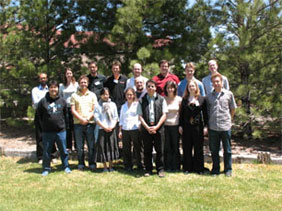NRAO eNews Volume 3, Issue 2 • March 1, 2010
Upcoming Events
 SKA2010 - International SKA Science and Engineering Meeting
SKA2010 - International SKA Science and Engineering Meeting
March 22–25, 2010 | Manchester, UK
 Cometary Radio Astronomy
Cometary Radio Astronomy
May 17–19, 2010 | Green Bank, WV
 Preparing for ALMA
Preparing for ALMA
May 24, 2010 | 6:00 - 8:00 PM EDT | AAS Meeting Special Session | Miami, FL
 NRAO Proposal Deadline
NRAO Proposal Deadline
June 1, 2010 | 5:00 PM EDT
 12th Synthesis Imaging Workshop NRAO & New Mexico Tech
12th Synthesis Imaging Workshop NRAO & New Mexico Tech
June 8–15, 2010 | Socorro, NM
Earthquake in Chile
Fred K.Y. Lo
As you likely know, a major earthquake occurred in Chile early Saturday morning, February 27, that was centered about 60 miles off the northwest coast of Chillan, Chile. Santiago is 200 miles northeast of the quake's epicenter. Numerous aftershocks have occurred.
I am relieved to report that the NRAO/AUI has been able to contact and account for its staff based in or visiting Chile, and there appear to be no injuries to them or their families. As of this morning, 1 March, communication is improving though still challenging: our network connections to the outside world from Chile are operational but at lower bandwidth. The ALMA Array Operations Site and Operations Support Facilities in northern Chile suffered no damage other than temporary loss of communications.
Our thoughts are with our staff, colleagues, and the people of Chile and neighboring countries who have been affected by this earthquake. The NRAO and AUI are committed to assisting them and the recovery in every way possible.
BeSSeL: Mapping the Milky Way Structure and Dynamics with the VLBA
Mark Reid on behalf of the BeSSeL Team
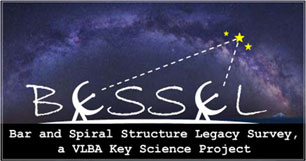
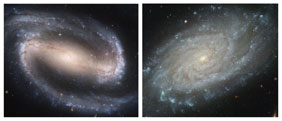
Figure 1: Two spiral galaxies (NGC 1330 and NGC3370) that probably share characteristics with the Milky Way.
Surprising but true, we know the structure of other galaxies far better than for the Milky Way. Since we are inside the Milky Way, it has proven very difficult to properly characterize its structure, because dust obscures most of the Galaxy at optical and, to some extent, infrared wavelengths, and distances beyond the extended Solar Neighborhood are quite uncertain. We are not sure whether the Milky Way is an SBb or SBc-type galaxy, and we don't even know how many spiral arms (2 or 4) it has. At present, we can probably only conclude that the Milky Way shares some characteristics of the two galaxies in Figure 1.
HI emission on Galactic longitude versus velocity plots clearly demonstrated that there are coherent, large-scale structures that probably are spiral arms. However, determining accurate distances to HI clouds proved problematic, and this made the task of turning longitude-velocity data into a true “plan-view” of the Milky Way very uncertain. Later, millimeter-wave observations of CO molecules also revealed coherent, large-scale structures with higher contrast than seen in HI. But, again, uncertain distances to molecular clouds precluded making a true map of the Milky Way with sufficient accuracy to trace its spiral structure.
Massive, young and hot stars in star-forming regions ionize their surrounding gas and delineate the spiral structure of galaxies. Thus, measuring distances to massive, young stars will allow us to map directly the spiral structure of the Milky Way. Fortunately, clouds of gas closely associated with forming or newly formed OB-type stars emit strong maser emission (e.g. from methyl alcohol and water molecules) and these are excellent astrometric targets. Recent dramatic improvements in radio astrometry with the NRAO Very Long Baseline Array (VLBA) and the Japanese VLBI Exploration of Radio Astronomy (VERA) array have yielded parallaxes to masers in star forming regions across a significant portion of the Milky Way with accuracies of ~10 μas (see references in Reid et al 2009, ApJ, 700, 137). This accuracy corresponds to a 10 % uncertainty on distances measured at 10 kpc.
An international team of 15 people is now starting a NRAO Key Science Project with a goal of mapping large portions of the Milky Way by measuring parallaxes to several hundred regions of massive star formation. This project will require about 5000 hours of VLBA time over the next 5 years. The project acronym "BeSSeL" stands for "Bar and Spiral Structure Legacy" survey and honors Friedrich Bessel who measured the first stellar parallax in 1838. This radio astrometry approach is the only direct way to map the entire spiral structure of the Milky Way.
In addition to parallaxes, BeSSeL will also obtain proper motions with accuracies of ~20 μas/yr, which translates to better than 1 km/s for most sources. Combining the source position, distance, Doppler velocity, and proper motion yields all phase-space information (i.e., three-dimensional position and velocity vectors). This complete information allows one to model the dynamics of the Milky Way extremely well, with consequences for the dynamics of the Local Group.
Future space missions like Gaia or the Space Interferometry Mission (SIM), which may have comparable astrometric accuracy, will operate at optical wavelengths but cannot see through the dust in the plane of the Milky Way, nor to deeply embedded regions of star formation. However, the combination of astrometric measurements of halo stars with Gaia or SIM and massive star-forming regions in the Galactic plane with BeSSeL should lead to a very detailed understanding of the structure and gravitational potential of the entire Milky Way.
Current parallax and proper motion measurements suggest the Galactic rotation speed at the Sun is 15 % greater than the IAU adopted value of 220 km/s. If this result is confirmed by the BeSSeL survey, then the Milky Way and Andromeda galaxies may have similarly massive dark matter halos. This would strongly affect the fate of the Milky Way in a likely future collision with the Andromeda galaxy. In addition, increasing the rotation speed of the Milky Way is crucial to understanding if the Magellanic Clouds are bound to the Milky Way in two ways: (1) it decreases the approach speed of the Clouds with respect to the center of the Milky Way; and (2) it increases the gravitational potential of the Milky Way. It has similar impact on understanding the orbits and history of the other satellites of the Milky Way.
Spiral density wave theory developed nearly a half-century ago has yet to be well tested in the Milky Way. Initial results from our pilot parallax and proper motion measurements indicate that massive star-forming regions orbit the Galaxy slower than for a circular orbit. This might be explained by molecular clouds encountering spiral arm shocks and triggering star formation at apocenter on elliptical Galactic orbits. The BeSSeL survey should provide the detailed three-dimensional kinematic information that will be critical to advances in spiral density wave theory.
Finally, the Milky Way is thought to possess a bar-like structure in its central 3 kpc region. A bar provides strong gravitational forces, which should result in dramatic departures from circular orbits for matter in its vicinity. Indeed, some large non-circular motions have been detected in our pilot measurements for sources near the bar. The BeSSeL survey will provide an excellent foundation for understanding the nature and impact of the Milky Way's bar.
Preparing for ALMA: A Special Session at the 216th AAS Meeting
Mark Adams and Al Wootten
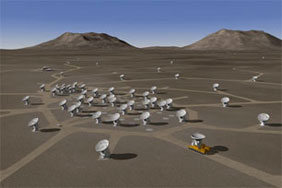
An artist's conception of ALMA in a compact configuration (image courtesy ESO).
A Special Session titled 'Preparing for ALMA' will be held on Monday, 24 May 2010, 6 – 8 p.m. EDT during the next summer meeting of the American Astronomical Society in Miami, Florida. The first call for ALMA observing proposals is expected in a little less than a year, while construction continues. This Special Session will describe the Early Science opportunity, as well as the ALMA tools and support available through the North American ALMA Science Center (NAASC) located at the NRAO headquarters in Charlottesville, Virginia. The NAASC staff will provide accurate and timely information on ALMA observing modes and capabilities to the community, support users creating proposals with the ALMA Observing Tool, staff an electronic Help Desk, validate observers’ scheduling blocks, and provide post-observation user support.
The Special Session will include an introduction to the major tools that users will to prepare their observations and analyze their data, including the ALMA Observing Tool (OT) for proposal preparation and submission, the Common Astronomy Software Applications (CASA) package that will be used to reduce ALMA science data and includes an “observing simulator” task, and Splatalogue, an on-line VO-queryable spectral line database.
During Early Science, ALMA is expected to include at least 16 antennas, 4 receiver bands, baselines to 0.25 km, and single field interferometry. Goals will include offering baselines to 1 km and single dish mapping of extended objects in continuum and spectral line modes. While Early Science will coexist with array commissioning, a portion of the available time will be allocated for science observations.
ALMA Commissioning Begins
Al Wootten

Figure 1: A new interferometer, comprised of Vertex antenna DV03 (right) and antenna DV05, lies at the end of the rainbow at the ALMA Operations Support Facility. The antenna transporters are housed in the building at left. © ALMA (ESO/NAOJ/NRAO), A. Wootten (NRAO).
The year 2010 began auspiciously at ALMA with the commencement of the commissioning and science verification tasks, using the three antennas operating at the Array Operations Site (AOS) at 5050m (16,500 ft) altitude. A small ceremony was held 22 January 2010 to mark the occasion, exactly one year since first light on an ALMA antenna. The ‘altiplanic winter’ conditions found during many austral summers have been much less severe in recent years.
The commissioning team has made good use of the time to work on commissioning correlator modes, calibration devices, line length correctors, water vapor radiometers, and other equipment to ready the instrument for the call for Early Science proposals expected in about a year. Much of the testing is sequenced through ‘Schedule Blocks,’ sets of instructions generated by the ALMA Observing Tool (OT). This is the software that observers will use to submit observing proposals and, after acceptance, to generate instruction blocks to execute observations. Several realistic test observations have occurred through the use of this software, including data collection from amplitude, pointing, and phase calibrators as well as from target sources.
New ALMA antennas and Front Ends have been accepted. Two Vertex antennas are now operating as a test interferometer undergoing a battery of tests by the Assembly, Integration and Verification (AIV) and science teams at the 2900m-elevation Operations Support Facility (OSF). This process will lead to their joining the growing array on the high-elevation Chajnantor plain soon. Two other antennas have just been accepted (DV04 from Vertex, PM02 from Mitsubishi) and will soon be transported to the OSF for optical pointing tests, holography, and then radiometric tests. ALMA has now accepted seven antennas. An additional 17 antennas are in various stages of construction in the contractor antenna camps at the OSF. New Front Ends also continue to arrive to keep up with the antenna flow. Receiver cartridges for ALMA Band 4 (λ ~ 2 mm) and Band 8 (λ ~ 0.6mm) have been received from the National Astronomical Observatory of Japan and will soon be incorporated into dewars that will be shipped to Chile.
At the end of February 2010, two of the antennas at the AOS will be moved from their current location on pads with baselines of ~ 200m to pads that will eventually hold the 7m antennas of the Atacama Compact Array (ACA). One antenna will remain ~ 1 km away so that tests of long baselines may proceed. In about a month, all three antennas will be stationed on ACA pads and will be supplied with power from a central source.
Life as a NAASC CSV Liaison
Kartik Sheth
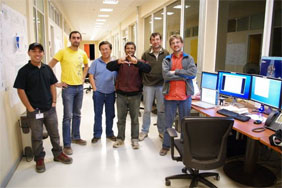
A triumphant moment captured at the OSF: Some of the team responsible for achieving ALMA phase closure (image courtesy Kartik Sheth).
When I departed Charlottesville in late November to spend 4.5 months in Chile as a Commissioning & Science Verification Liaison for the North American ALMA Science Center (NAASC), I had no idea that Charlottesville would experience its snowiest winter. My assignment in Chile was very timely!
The NRAO/AUI and Joint ALMA Observatory offices in Santiago, Chile are located in Las Condes, the modern business section of the city. If you like modern architecture, a stroll on any of the streets in this part of Las Condes is a must! The architects who designed the tall glass and steel marvels that line these streets incorporated gentle curves and remarkable angles in their buildings that make one do double takes. The glass-enclosed elevator ride to the 19th floor offices is exhilarating even after three months of workdays. The office interior is generic and is divided into cubicles that recall the Dilbert cartoon series. But unlike most other offices, these provide spectacular views of Santiago and the Andes mountains that lift your spirits even when the challenges of commissioning do not.
The Commissioning and Science Verification (CSV) scientists -- including all Liaisons from the ALMA Regional Centers such as the NAASC -- travel from Santiago to the Operations Support Facility (OSF) in northern Chile once a month for an 8-day “turno.” Each turno trip starts with a taxi ride to the Santiago airport to catch a 1.5 hour flight to Calama, a city of 150,000 people in northern Chile (Region II). CSV scientists are met in Calama by a large red, white, and blue bus that transports arriving employees to ALMA and the OSF, a drive of two hours. The OSF is a tiny city perched on the slopes of the Andes at 2,900m (10,000 ft) elevation, not far from the small town of San Pedro de Atacama, a popular tourist destination of the Atacama Desert.
As a CSV team member, you are assigned to either the day or the night shift at the OSF. The day shift tracks down problems and analyzes data acquired the previous night, interacting with the software and hardware engineers, and the operators. At 3 p.m. a daily videoconference with the Santiago staff reviews the day's activities and plans the coming night. The array is usually handed over from software and hardware testing to the scientists between 6 and 10 p.m., and the CSV team runs tests until about 4 a.m.
In between array commissioning tasks, CSV scientists do find some time for short hikes around the ALMA site, to use the small but well-equipped gymnasium, or to go for a bike ride. But every activity is done with care owing to the altitude and the dry desert conditions. The only occasional complaint is about the cafeteria food, especially for vegetarians and vegans, though the food is improving. Although you do not realize it at first, by the sixth day the high altitude and long work hours begin to slow you down, and you begin to look forward to the end of your turno. And then, a month later, the sequence begins anew!
The primary challenges for a vast, international project such as ALMA remain the transfer of information from person to person, especially in the turno system where personnel often take several days off after the exhausting OSF shifts, and the overwhelming number of wiki pages and meetings. But these are the usual and, in my opinion, relatively trivial problems, especially compared to the excitement of watching ALMA come to life. I was pleased to be present the night ALMA obtained phase closure with the first three antennas at the high-elevation Chajnantor site, and the excitement and joy that everyone felt was incredible: the culmination of hard work over years by so many people, and the beginning of interferometry with ALMA. Though being away from home is always difficult, my time in Chile and with ALMA has been a fantastic experience and I look forward to being back again, during another northern hemisphere winter!
The 2010 NRAO Postdoctoral Symposium
James Miller-Jones, Rachel Rosen, Miller Goss
The NRAO is organizing its 6th annual postdoctoral symposium, to be held at the Green Bank, WV site from 18-20 April 2010. NRAO currently has 18 postdoctoral researchers across all sites, and the symposium provides an opportunity for them to come together once a year to present their work, discuss ideas, and form new collaborations.
The venue for the symposium rotates each year between the NRAO sites, affording the participants an opportunity to interact with local staff and showcasing the instrumentation and technological development that is on-going at each site.
The symposium, to which all NRAO postdocs are invited, will comprise scientific talks from the postdocs, an overview of the GBT and its capabilities from local staff, and a scientific talk from an ‘alumnus’ of the NRAO postdoctoral program. We are delighted that Rachel Osten, currently an Assistant Astronomer at the Space Telescope Science Institute, has kindly agreed to fill that role this year. Visiting astronomers from other sites and all NRAO staff are also welcome to attend.
Visit the symposium website for more information
GUPPI Development Update
Scott Ransom and Paul Demorest
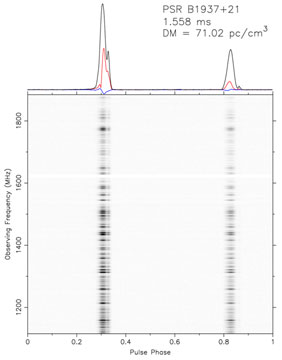
Figure 1: Flux as a function of spin phase and radio frequency for the original millisecond pulsar B1937+21, observed with GUPPI and the GBT. The integrated full-Stokes profile is shown on top (linearly polarized flux in red, and circular in blue). Narrow features, that can substantially improve timing measurements, such as the ‘notches’ visible on the pulse trailing edges have scales of ~10 micro-sec and are unresolvable without coherent de-dispersion.
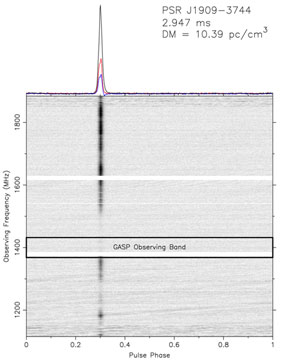
Figure 2: Similar to Fig. 1, but for PSR J1909-3744, one of the best timing pulsars for the NANOGrav project (the RMS timing residuals over several years are ~ 80 ns). The flux variation versus frequency is caused by interstellar scintillation, and changes on a timescale of hours. With an order of magnitude more bandwidth, GUPPI is much less sensitive to epoch-to-epoch signal-to-noise fluctuations than lower-bandwidth instruments such as GASP.

Figure 3: The GUPPI hardware in the GBT equipment room. GUPPI is comprised of 2 CASPER FPGA-based "iBob"s and iADC boards, a BEE2 compute engine, a 10gigE switch, and a cluster of 9 computer nodes each containing a high end graphics processing unit (GPU) used for the TeraFLOP of real-time coherent dedispersion calculations.
At the end of December 2009, a major milestone was reached in the development of the Green Bank Ultimate Pulsar Processing Instrument (GUPPI). The core team of Paul Demorest, Randy McCullough, Jason Ray, John Ford, and Scott Ransom achieved the exact removal of the dispersive effects of the interstellar medium -- a process known as coherent de-dispersion -- over the full 800 MHz of the available bandwidth for the Green Bank Telescope (GBT) L-band receiver. Coherent de-dispersion over such a wide bandwidth greatly improves the sensitivity and timing precision of pulsar observations with the GBT.
Over the past year, the original "digital filterbank" form of GUPPI has become the workhorse pulsar instrument at the GBT. Its wide bandwidth (up to 800 MHz), high-dynamic range (8-bit sampling), and excellent RFI resistance (due to the dynamic range and high-quality polyphase filterbank channels) have allowed it to completely replace and improve upon the GBT Spigot. The new GUPPI coherent de-dispersion capability will allow it to replace GASP, the high-precision timing backend that is used at Green Bank for such high-profile projects as North American Nanohertz Observatory for Gravitational Waves (NANOGrav) and the timing of the double pulsar, J0737-3039.
To perform the coherent de-dispersion, the CASPER-based FPGA system sends baseband-sampled data to a nine-node cluster of high-performance Graphics Processing Units (GPUs) that perform the ~ 1TeraFLOP of real-time computing required. The new modes will become available in the standard GBT observing system over the next few months.
Alan Rogers Awarded 2010 Grote Reber Medal
Ken Kellermann
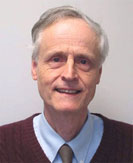
The 2010 Grote Reber Gold Medal for outstanding and innovative contributions to radio astronomy has been awarded to Dr. Alan Rogers, a Research Affiliate at the Massachusetts Institute of Technology Haystack Observatory. Rogers is being honored for his many pioneering developments in radio and radar interferometry, radio spectroscopy, and for his applications of radio astronomy techniques to society.
Rogers received his B.Sc. degrees in mathematics and physics from the University College of Rhodesia in 1962, and his S.M. and Ph.D. degrees in Electrical Engineering from MIT in 1964 and 1967, respectively. Following a year as a Lecturer at the University of Zimbabwe in 1968, he has been at the Haystack Observatory where he was the Associate Director until his retirement in 2006.
Rogers is best known for his contributions over many decades to the techniques of very long baseline interferometry. More recently, he developed an innovative radio array that he successfully used to detect the 327 MHz line of interstellar deuterium, capping a 40-year quest for this important astrophysical atomic gas. Currently, Rogers is searching for the low frequency signature characteristic of the cosmic epoch of reionization using a digital spectrometer and a compact broadband dipole.
He was also the leader of a program to apply radio astronomy techniques to locate emergency calls from mobile telephones and is currently conducting a program to monitor atmospheric ozone using inexpensive consumer satellite TV low noise amplifiers and dishes.
The 2010 Reber Medal will be presented to Alan Rogers in July 2010 in Hobart, Tasmania at the annual meeting of the Astronomical Society of Australia. The Reber Medal was established by the Trustees of the Grote Reber Foundation to honor the achievements of Grote Reber and is administered by the Queen Victoria Museum in Launceston, Tasmania. Nominations for the 2011 Medal may be sent to Martin George, Queen Victoria Museum, Wellington St, Launceston, Tasmania 7250, Australia or by e-mail to: martin@qvmag.tas.gov.au to be received no later than 15 October 2010.
Recent NRAO Press Releases
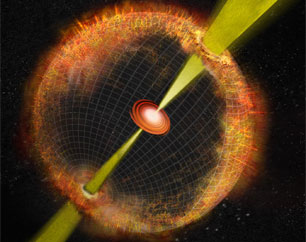
Astronomers Find Rare Beast by New Means (January 27, 2010)
For the first time, astronomers have found a supernova explosion with properties similar to a gamma-ray burst, but without seeing any gamma rays from it. The discovery, using the National Science Foundation's Very Large Array (VLA) radio telescope, promises, the scientists say, to point the way toward locating many more examples of these mysterious explosions.

Student Discovers New Pulsar
(January 19, 2010)
A West Virginia high-school student has discovered a new pulsar, using data from the giant Robert C. Byrd Green Bank Telescope (GBT).
Shay Bloxton, 15, a participant in a project in which students analyze data from the radio telescope, spotted evidence of the pulsar on October 15. Bloxton, along with NRAO astronomers observed the object again one month later. The new observation confirmed that the object is a pulsar, a rotating, superdense neutron star. Bloxton is a sophomore at Nicholas County High School in Summersville, West Virginia.
From the Archives
Ellen Bouton

In May 1982, in the Green Bank warehouse where the work was done, John Payne (left) and John Findlay contemplate engineering issues during the fabrication process for the new surface and back-up structure that would convert the Tucson 36-foot telescope into a 12-meter telescope. The 36-foot telescope closed to be resurfaced and upgraded on 15 July 1982; the first observations with the 12-meter telescope were made on 17 January 1984.
From the Archives is an ongoing series illustrating NRAO and U.S. radio astronomy history via images selected from our collections of individuals' and institutional papers. If readers have images they believe would be of interest to the Archives, please contact Ellen Bouton.
Career Opportunities
New Postings
Chief of Staff – ALMA: The Joint ALMA Observatory (JAO) is seeking a Chief of Staff for the Atacama Large Millimeter Array (ALMA) to support and assist the ALMA Director in the discharge of duties. The Chief of Staff will provide coordination and oversight of all actions required by the JAO Director's Office from JAO department heads and project managers ensuring implementation of initiatives.
EVLA Postdoc: The Expanded Very Large Array (EVLA) will begin offering Shared Risk Observing to the user community in March 2010. NRAO invites applications for an EVLA Commissioning Postdoc position which will be 50% independent research, and 50% assisting with the scientific commissioning of the EVLA. The successful candidate will help define observing procedures, test telescope performance, develop calibrator databases and calibration pipelines, and to assist with the development and testing of other hardware or software capabilities needed for the successful operation of the EVLA.
NAASC Postdoc: The North American ALMA Science Center (NAASC) located at NRAO headquarters in Charlottesville, VA (on the campus of the University of Virginia) invites applications for a postdoctoral fellow to work with the NAASC scientific staff as it gears up to support the needs of the community when ALMA early science begins in 2011. The successful candidate will be encouraged to use the ALMA data reduction and analysis package CASA (Common Astronomy Software Applications, see http://casa.nrao.edu/ for details) in their scientific research and provide feedback, and will help develop ALMA tutorials and other user-outreach materials.
Software Engineer II (CASA Programmer): The Common Astronomy Software Applications (CASA) group has an immediate need for development of high-performance computing algorithms/packages and cluster environment support. The Software Engineer will develop high-performance computing algorithms/packages and cluster environment support.
Software Engineer II (SSS Programmer): We are seeking a Software Engineer to be part of a team that creates software that allows astronomers from all over the world to configure observations on the Expanded Very Large Array (EVLA). In addition to writing the observation preparation software, the team also writes software for accessing the data taken by the telescope, and in-house software for scheduling observations on the instrument.
ALMA Science Operations Astronomers: The Joint Atacama Large Millimeter/submillimeter Array (ALMA) Office invites applications for the position of Science Operations Astronomer, based primarily in the ALMA offices in Santiago, Chile. The successful candidates will support the Commissioning and Science Verification team, assisting the Project Scientist in planning and executing the scientific commissioning of ALMA before ALMA early science operations (2011) and will participate in tests and evaluations of the ALMA control software and software tools for science operations, and in the planning of science operations.
Software Engineer II (CASA): The National Radio Astronomy Observatory is seeking a Software Engineer II for their Common Astronomy Software Applications (CASA) division in Socorro, New Mexico. Astronomers and programmers from US, Europe, Canada, Japan, and Chile are actively developing and using CASA. There are several Qt based applications that will need to be extended and supported by the Software Engineer.
Software Engineer III: The National Radio Astronomy Observatory in Socorro, NM is seeking a skilled developer to participate in the development of the observation scheduling and pipeline data-reduction subsystems. The successful candidate will display a strong working knowledge of Java and of object-oriented analysis and design. The ability to learn new computer techniques (languages, methodologies, etc.) quickly and independently is required. Excellent software technical documentation skills are required.
Assistant Scientist/A: The team of scientists at the Green Bank Telescope (GBT) is seeking an Assistant Scientist/A to provide full scientific support to the GBT and the NRAO. Responsibilities will include supporting observers who use the telescope as well as working on a diverse variety of projects, which may include the development and commissioning of new instrumentation on the telescope, working with the engineering staff to improve the overall telescope performance, and aiding with the data reduction pipelines needed for the GBT. The position will be filled at the assistant, associate, or scientist level, depending on experience.
Software Engineer II: The Software Development Division in Green Bank, WV is seeking a Software Engineer to help design, develop, implement, and support the Dynamic Scheduling System for the Green Bank Telescope. The Dynamic Scheduling System is broken into three major components: a web application built with the Django web development framework, a series of custom user interfaces built with Ext GWT, and the core scheduler implemented in the functional programming language, Haskell. The Dynamic Scheduling team uses agile software development methods and automated unit testing to provide a working system for sponsors at every step of system development.
Software Engineer III: The Software Development Division in Green Bank, WV, is seeking a Software Engineer to provide support for the scientists who use the Green Bank Telescope (GBT). Work will be directed initially toward improvements in the post-observing data analysis and reduction software as well as developing data reduction and analysis software infrastructure for existing instrumentation.

 Zoom
Zoom